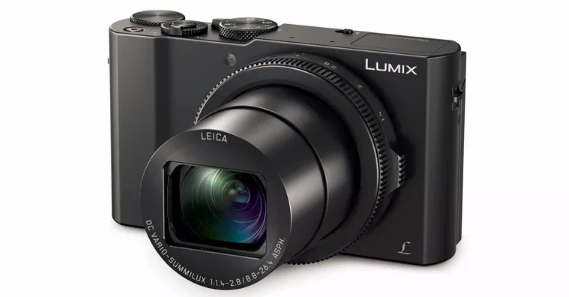Panasonic Lumix LX10 To Battle Canon PowerShot G7 X Mark II for Vlogging Supremacy?
As some of you already know, I recently got myself a Canon PowerShot G7 X Mark II, which the most followed Youtube vloggers describe as 'the best point-and-shoot camera for video recording' that money can buy as of today.
I've been playing with the digicam for several days now and I have to agree with them. The video quality that I get from my G7 X Mark II - apart from the quality of stills - is absolutely top-notch. (I'll be sharing vlogs taken using the camera soon! Stay tuned!)
That said, it's really no wonder that the product is doing very well in various key markets and that other imaging giants like Panasonic are now taking a page or two from Canon's strategy.
Take the freshly announced Panasonic Lumix LX10 for example.

Equipped with a 3-inch LCD touch display that can flip all the way up 180-degrees - just like the G7x Mark II (and unlike the LX100 and LX7), it's obvious that this new digital camera is made for vlogging -- apart from its standard functionality.


As expected from a newer release, however, Panasonic Lumix LX10 comes with a number of features that are better than what you'll find on competing devices that preceded it; Most notable of which are its ability to record 4K videos at 30fps (or 24p in MP4) and the wider F1.4-2.8 aperture range of its LEICA DC VARIO-SUMMILUX lens (35mm camera equivalent: 24-72mm), allowing it to shoot stills and record videos with shallow depth of field or 'bokeh' effect. In comparison, G7 X Mark II can shoot Full HD 60fps videos and has an aperture range of F1.8-2.8.

Aside from the above-mentioned product highlights, this metal-clad point-and-shoot also has the following specifications:
1. 1-inch High Sensitivity MOS Sensor with 20.1 MegaPixel resolution
2. Minimum working distance of 3 cm for stunning macro shots
3. Maximum ISO 12,800 high sensitivity recording with high picture quality
4. High-speed, high-precision AF with DFD (Depth From Defocus) technology
5. Ultrahigh-speed AF of approx. 0.12 seconds
6. High-speed burst shooting at 10 fps (AFS) / 6 fps (AFC)
7. 4K PHOTO shots with Focus Stacking, Post Focus, Light Composition, and 4K Live Cropping derivative functions
8. RAW format shooting
9. 5-Axis Hybrid Optical Image Stabilizer Plus
10. WiFi connectivity support

Panasonic Lumix LX10 will don an official SRP of $699 USD (that's Php 33,550 with current conversion) when it hits store shelves come November 2016.
I've been playing with the digicam for several days now and I have to agree with them. The video quality that I get from my G7 X Mark II - apart from the quality of stills - is absolutely top-notch. (I'll be sharing vlogs taken using the camera soon! Stay tuned!)
That said, it's really no wonder that the product is doing very well in various key markets and that other imaging giants like Panasonic are now taking a page or two from Canon's strategy.
Take the freshly announced Panasonic Lumix LX10 for example.

Equipped with a 3-inch LCD touch display that can flip all the way up 180-degrees - just like the G7x Mark II (and unlike the LX100 and LX7), it's obvious that this new digital camera is made for vlogging -- apart from its standard functionality.

It even looks a lot like the Canon PowerShot G7 X Mark II when you look at it from various angles. I don't think anyone can deny that.

As expected from a newer release, however, Panasonic Lumix LX10 comes with a number of features that are better than what you'll find on competing devices that preceded it; Most notable of which are its ability to record 4K videos at 30fps (or 24p in MP4) and the wider F1.4-2.8 aperture range of its LEICA DC VARIO-SUMMILUX lens (35mm camera equivalent: 24-72mm), allowing it to shoot stills and record videos with shallow depth of field or 'bokeh' effect. In comparison, G7 X Mark II can shoot Full HD 60fps videos and has an aperture range of F1.8-2.8.

Interestingly, it also lacks a built-in viewfinder and a mount or slot for attaching an external one.
Aside from the above-mentioned product highlights, this metal-clad point-and-shoot also has the following specifications:
1. 1-inch High Sensitivity MOS Sensor with 20.1 MegaPixel resolution
2. Minimum working distance of 3 cm for stunning macro shots
3. Maximum ISO 12,800 high sensitivity recording with high picture quality
4. High-speed, high-precision AF with DFD (Depth From Defocus) technology
5. Ultrahigh-speed AF of approx. 0.12 seconds
6. High-speed burst shooting at 10 fps (AFS) / 6 fps (AFC)
7. 4K PHOTO shots with Focus Stacking, Post Focus, Light Composition, and 4K Live Cropping derivative functions
8. RAW format shooting
9. 5-Axis Hybrid Optical Image Stabilizer Plus
10. WiFi connectivity support

On paper, this model appears more than promising. I'd love to give it a test run when it becomes available later this year. Off hand, I hope it doesn't get hot when recording 4K clips and that its video quality is as good as the best of them. Also, I want to see for myself if its autofocus performance reflects what's on the specs sheet.
Panasonic Lumix LX10 will don an official SRP of $699 USD (that's Php 33,550 with current conversion) when it hits store shelves come November 2016.
Labels:
Cameras
Featured
Imaging
Panasonic Lumix LX10
Panasonic Lumix LX10 vs Canon PowerShot G7 X Mark II
Point-and-Shoot Digicams

